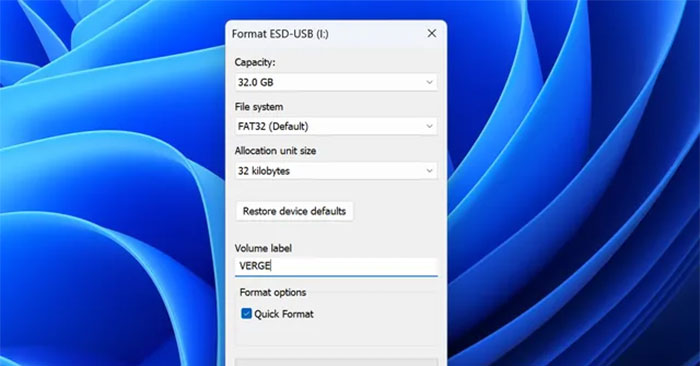Microsoft is finally increasing the FAT32 size limit
 Microsoft is finally increasing the FAT32 size limit Picture 1
Microsoft is finally increasing the FAT32 size limit Picture 1
FAT, short for File Allocation Table, is a file system originally designed for floppy disks developed by Microsoft in 1977. FAT has been applied on hard drives and other storage media. and is the default file system for some Microsoft operating systems. Until 2001, FAT was converted to NTFS on Windows XP.
According to former Windows developer Dave W Plummer, he was responsible for introducing a format size limit of 32GB.
After about 30 years, Microsoft has finally solved the problem of FAT32's size limit. The latest Canary release of Windows 11 (build 27686) increased the FAT32 size limit from 32GB to a much larger 2TB. However, you need a third-party tool to create this partition. Although the partition limit for FAT32 is being expanded, there is still a 4GB size limit for individual files stored on a FAT32 drive.
FAT32 is not widely used today and has been replaced by more modern file systems such as NTFS and exFAT. But it is still used by many older devices that require a FAT32 formatted USB drive or SD card.
You should read it
- What is the difference between exFAT, FAT32 and NTFS?
- What is FAT32, NTFS, exFAT format?
- How to format an external hard drive to FAT32?
- How to Format SD Card to FAT32: A Brief Guide
- How to Format FAT32
- What is NTFS? What is FAT32? Compare NTFS and FAT32
- How to switch from FAT32 to NTFS without losing data with the CMD command in Windows 7,8,10
- What are the exFAT, FAT32 and NTFS formats and how are they different?
- How to convert a FAT32 hard drive to NTFS on Windows does not lose data
- Tips for reformatting USB to run on Windows, Linux, Mac and many other operating systems
- Why does USB drive, memory card ... use FAT32 format instead of NFTS?
- The convert in Windows command
May be interested

Apple shows how it's possible to try out the new iPhone inside the Vision Pro

4 ways to make blurry photos sharp

NVIDIA quietly launched the RTX 2000E 'Ada' graphics card, what's remarkable?

OpenAI is worried that users will 'love' ChatGPT, affecting interactions between people

Brave - Fast and secure personal web browser

5 best PlayStation 5 controllers






 Increase the size of attachments in Outlook 2010
Increase the size of attachments in Outlook 2010 What is the difference between exFAT, FAT32 and NTFS?
What is the difference between exFAT, FAT32 and NTFS? What is FAT32, NTFS, exFAT format?
What is FAT32, NTFS, exFAT format? How to format an external hard drive to FAT32?
How to format an external hard drive to FAT32? How to Format SD Card to FAT32: A Brief Guide
How to Format SD Card to FAT32: A Brief Guide How to Format FAT32
How to Format FAT32